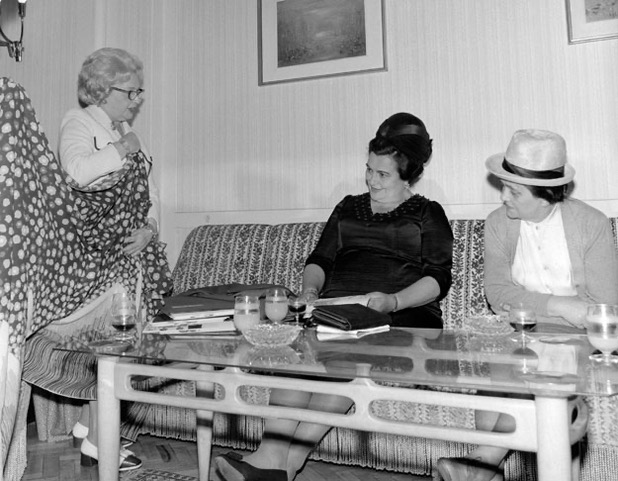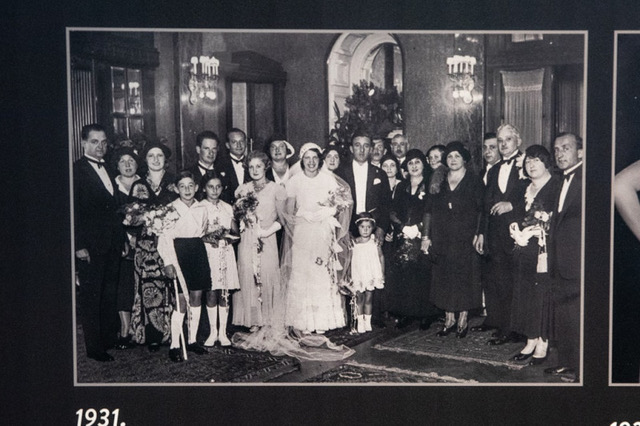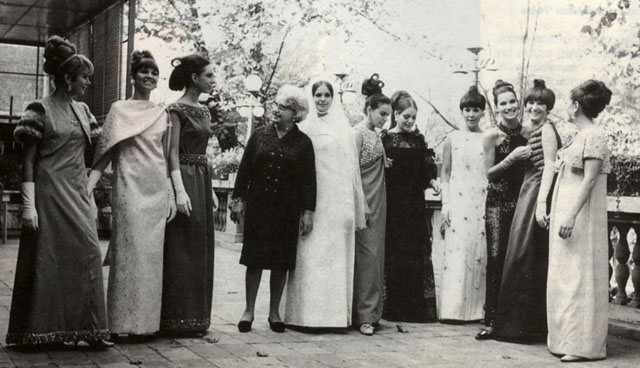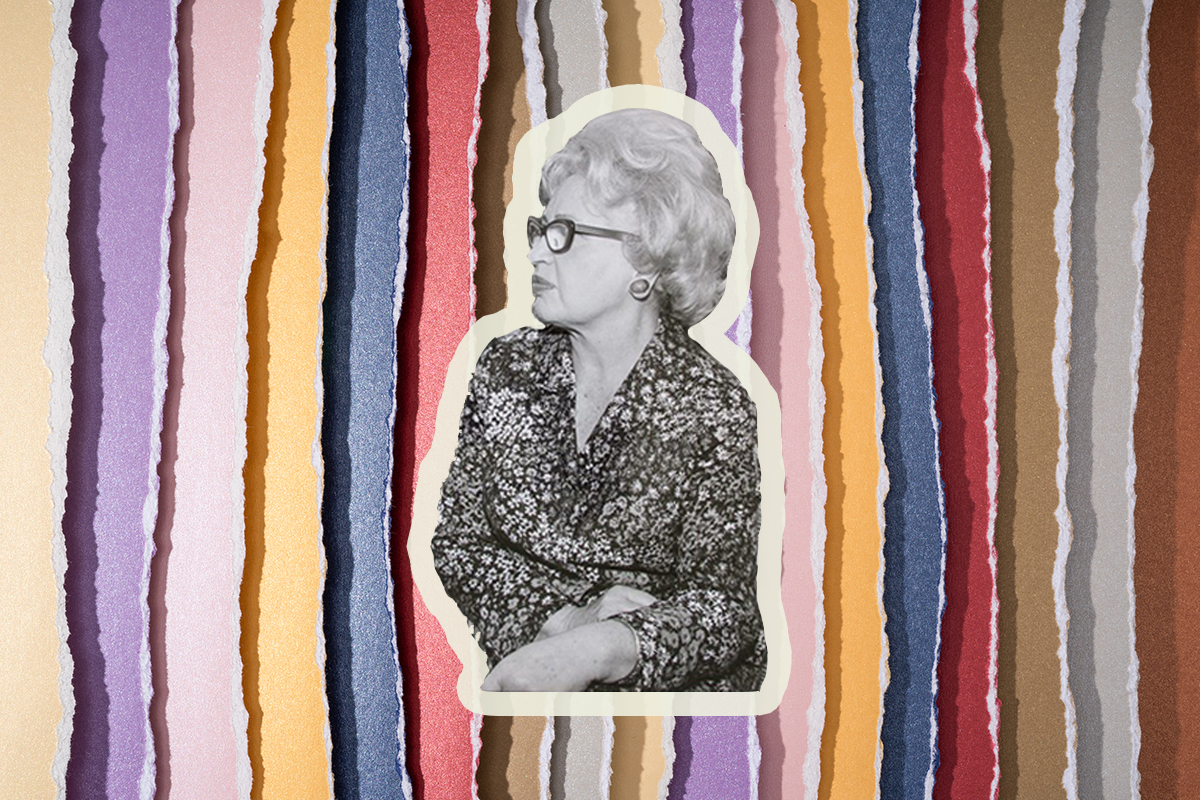There is a certain kind of dress a certain kind of woman has in her closet. She is most likely Hungarian, though not necessarily, but she is definitely of a certain age. The dress is of a fine material and sophisticated cut, with a distinctly European flair that reflects the era it hails from. It has a tag that reads “C R” and was made in Budapest. And while the woman wearing the dress might not be Jewish, its designer, Klara Rotschild, certainly was.
Klara Rotschild’s clothes were of a quality on par with the finest Parisian couture. Zippers were concealed behind fabric, patent buttons covered in silk. Beads and lace were sewn by the hands of other Jewish women with a desire for perfection just like that of the one whose name they worked under.
She made dresses for Louis Joseph Cartier’s wife Jacqueline, for Egyptian king Farouk’s mother and sisters. She designed costumes for the wives of Vranitzky, Tito, and Hungarian socialist leader Kádár. She clothed pianist Annie Fisher and stars like Zsa Zsa Gabor and Gina Lollobrigida. She even dressed the bride for her wedding to Hungarian Nazi-era leader Miklós Horthy’s son.

Indeed, Klara was a Jewish woman who survived war and tyranny to become the most celebrated fashion designer Hungary ever saw. How could someone like her dictate what the gentile ladies of the ruling class and the political elite of the 20th century ought to wear? Because she knew, and they didn’t.

Klara Rotschild was born in Budapest on February 22, 1903 to Abraham Rothschild, a tailor, and Regina Spirer, a seamstress. Only attending school for six years before becoming “directrice” at her parents’ salon, she tended to the relationships with customers, overseeing the bookkeeping and billing. When her parents divorced in 1916, Klara went to work at her father’s new store, often accompanying him on trips to Paris where she developed an eye for form, fit, and fashion.
Klara married Pal Glücksthal, a wealthy textile merchant, in 1931 at age 28, rather late for the time. Not much is known about him or their marriage, except for the fact that they doted on one another and looked forward to a life of happiness.

One day, Klara was sent to bon-vivant Pál Károly Somogyi’s residence to collect outstanding payment for her father’s salon. He assaulted her, and the incident scarred Klara deeply. When her mother died not long after, she attempted suicide and was sent to therapy. She eventually decided to sue Somogyi and won the case, which garnered her the attention of the Budapest press. The money awarded to her ultimately allowed Klara to open her own salon: At 33 years old, Klara dropped the h from her father’s name and launched her own brand.
At the time, Hungarian designers were regarded as simple merchants of the lower middle class. So while Gabrielle “Coco” Chanel was a celebrated artist who regaled friends with souvenir bottles of Chanel No. 5, Klara was not given the right to see herself as anything but the provider of a necessity.
Perhaps due to this, it was common at the time for designers from Hungary to go to Paris and purchase the sewing patterns and styles of French couture best suited to the local tastes. In an interview with Magyar Narancs, Tamas Ungvari, noted Hungarian intellectual, recounts a time when his family took him along on a trip to Nazi-occupied Paris with Rotschild, his aunt. They put their yellow stars on at the border (not yet compulsory in Hungary) and took them off in Paris, even though that wasn’t allowed — this was Paris, there was a Balenciaga show, and Klara simply had to see it. Legend has it she was still searching for a venue for a fashion show as German troops were preparing to invade Budapest in December of 1944.
Soon, the rights of Jewish people in Hungary were being curtailed. It was Klara’s friendship with Righteous Among the Nations Raoul Wallenberg that spared her life: He gave her a letter of exemption from deportation. Still, her husband died in the winter of 1945, his body never found. Her father succumbed to the same illness not much later.
Klara survived the war and got to work in 1945, as if the worst era of humanity had not just taken from her everything she loved. By 1947, society welcomed her back with open arms until the communist era government seized her salon in 1952, keeping her on as the face of a store now called Különlegességi Női Ruhaszalon, “Specialty Women’s Dress Salon.” The store was allowed to be named Clara again in 1961. (Always given to airs of Western sophistication, Klara always used a “C” initial in the brand name, ostensibly to separate her salon from other, more mundane shops in Budapest.)
Political leaders soon realized Klara’s value in making socialist Hungary seem more worldly than it was, so when foreign dignitaries arrived, a visit to her salon was often on the schedule. That’s how Klara became friends with Josip Broz Tito’s wife, Jovanka, despite the language barrier. The Serbian first lady even gifted her a white poodle named Vogi (short for Vogue).
Soon, everyone in town knew that you could get exclusive dresses only at Rotschild. Prices were ludicrously high, yes, but they were still below those of French couture. Klara was allowed by the government to travel to Paris for the shows, to see Givenchy (Hubert was a friend of hers), Dior, Lanvin-Castillo, or Balmain. She bought their designs, adapted them to the Budapest palate, and presented her collection at Gundel or Gerbeaud.

Notwithstanding appearances, and while Klara’s name comes up here and there in the surveillance documents from the time, there is no sign of her ever having worked with authorities. While it would have been quite defensible, she never bowed to either system; be it the Nazis, the Communists, or even the more lenient and reciprocal “goulash-socialists.” Klara stayed alive through nothing but sheer will. She was also a brave, generous spirit and maternal character who loved her friends and colleagues and championed talent. Her seamstresses all got married in dresses she gifted them, with fabric ordered from Paris. She had a great sense of humor, and loved parties, card games, and the races.
Klara herself was a very elegant dresser, wearing the skirt costumes of her own brand with poise, always paired with beautifully framed glasses. She wore gloves outside of the house and got her hair set every day. She tried to pass as a gentile, even “baptized out” as they say in Hungary. But it was precisely her Jewishness that everyone ultimately fell for: her ability, her intellect, and her never-give-up dedication.
People often preface praise of Klara Rotschild with saying she wasn’t very innovative. But it is hard, now, to imagine what the socialist era of Hungary was like, how little impulse or inspiration it offered for someone in the fashion business, how starved of creative pursuit it truly was. Others compare her to Coco Chanel because of the similarity of their designs. But, Coco Chanel was a not-so-secret Nazi supporter, so while women may have her to thank for being able to wear pants today, Jewish women all over the world have Klara to look to for a true woman of valor.
Klara Rotschild died on November 13, 1976, not long after a wildly successful show at Gundel Restaurant. She ended her own life by jumping out of the window of her seventh floor apartment, ostensibly due to extraordinary pain from an unsuccessful tooth transplant. She was laid to rest at the Kerepesi cemetery in Budapest, her husband’s name written on her tombstone underneath hers. Her salon went on for a while after her death, but Clara wasn’t the same without Klara.
Under the address of Rotschild’s salon — Vaci street 12 — there is now an Estee Lauder store, another empire built by a Jewish woman of Hungarian origin, even if it’s one whose incredible talent fortunately wasn’t tread on by German boots or hidden behind a curtain made of iron.
All photographs courtesy of the Hungarian National Museum Archive.



